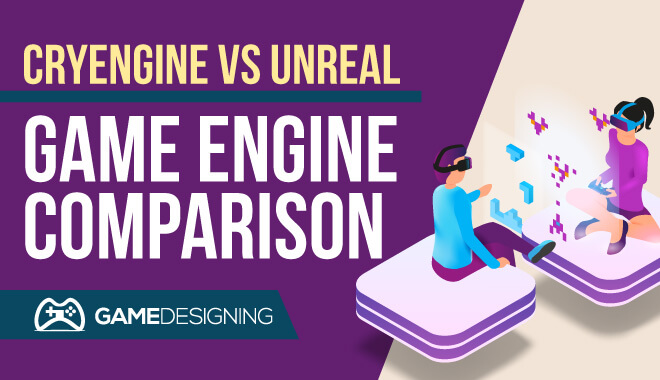
If you aren’t familiar with game engines, they are basically all the things ‘under the hood’ in games: the physics, graphics, sound, artificial intelligence, and much more.
Game engines allow the developer to more impressive feats when it comes to different aspects of the software. Based on things like software requirements, preference, and licensing, the game engine involved in a title can bring an impressive edge to a game.
Two of these engines, CryEngine, and Unreal Engine, are some of the most famous engines today. They each have their pros, cons, and unique aspects to cater to different game studios.
Let’s take a quick refresher of the two before we start comparing.
CryEngine
CryEngine came on the scene in May 2002, developed by the game developer Crytek. It has since been the go-to engine for games like Far Cry, Kingdom Come: Deliverance, and Crysis.
In the mid-2000s, it was so impressive visually that it spawned internet memes in the form of ‘Can it run Crysis?’ in which users would show off their computers, and others would respond with the catchphrase, a testament to the sheer power 2007’s Crysis required to run.
Since its inception, it has helped games reach their full potential and more.
Crysis and Environments

If you were a player of Crysis back in the day, (or today via a sweet sale on Steam), you will be familiar with how stunning the environments are within the game.
In its seminal title, Crysis, you are a special agent/super-soldier who is tasked with investigating an alien presence on a fictional island off the coast of the Philippines. When I first played this, I was stunned. The beautifully crafted environs pulled me into this strange sci-fi world where aliens existed. I was scared, intrigued, and excited.
That is the power of what CryEngine can do to environments.
However, some users have said that where CryEngine shines in the environmental design department, they lack in interior sets.
I have to agree on this point.
Out of all of the CryEngine titles, they kill it when it comes to foliage, nature, and exploring the natural world. However, once you inevitably make your way into a concrete bunker without much flair or personality, you will be longing for the creepy, immersive jungles of Crysis or Far Cry.
I would say this is a smaller gripe with the engine than most, but still important if you plan to use this engine for that purpose.
Pros:
- Stunning environmental potential: I dare you to find a better engine that generates environments this beautiful. Just look at all the Far Cry games. Regardless of your personal opinion, I believe that their environments are objectively masterful and immersive.
- Stronger graphical capability: Using CryEngine will allow you to really push the envelope in the graphics department. CryEngine delivers good visuals in spades.
Cons:
- Poor documentation: If you are a newer game developer, this could be a problem for you. If you are dependent on tutorials, you will need to consult outside sources most likely, like YouTube and special game sites.
- Not for beginners: Although stunning and impressive, the learning curve on CryEngine can be a little steep. This could be intimidating for newer developers just starting out and maybe too big a fish to fry.
Unreal
Unreal seems to have been around forever. I can recall games from what seems like forever ago touting ‘made with the Unreal Engine’ in the opening credits for as long as I can remember.
I may be exaggerating, since the Unreal engine came out in May 1998. It was the main engine to show off the then-new and impressive first-person shooter, Unreal, developed by Epic Games.
Although initially aimed towards games like Unreal, it soon rapidly developed into a staple of game development. To date, hundreds of games, from BioShock to 2020’s Dragon Ball Z: Kakarot, have utilized Unreal Engine’s fast running time and ease of functionality.
Unreal Engine is now in its 4th iteration, constantly building on what Epic Games have nailed down in previous versions. Newer particle systems have gamers in awe of Unreal’s stepping of environmental emphases.
Everyone remembers the first time they booted up the first Gears of War game. You were planted into a ramshackle world populated by grotesque alien invaders, as well as dilapidated interior and exterior environments. It was terrifying exploring mansions and sewers of the game world, and the engine showed what it was capable of in terms of environmental design.
Unreal has scored a great tagline for its engine: “Unreal Engine: The Platform behind Fortnite”. Now that’s an attention-grabber.
Let’s break down some aspects into the pros and cons.
Pros:
- Graphical versatility: Unreal Engine can cater to tons of different graphical demands. Whether it is the new Gears of War game, Gears 5, or a simpler game, Unreal Engine offers pros for both.
- Easier to edit: We all make mistakes, and game development is no different. The last thing you want to see is a game character break into a ‘t-pose’ in the middle of an emotionally charged cutscene. Using C++, one can easily edit issues in the script. If you are like me, (someone who saves multiple times while playing an RPG, even after I just saved), this is a great insurance policy.
- Free (with a caveat): Unreal Engine 4 is completely free. However, as somewhat of a con as well, you need to pay a 5% tax on revenue based on the game. This means all of the little ins and outs like microtransactions, retail sales, and more are collected by Epic Games. If you are okay with this little hiccup, then no worries. Furthermore, Unreal Engine 4 is
Cons:
- A full team is optimal: unfortunately, you most likely won’t be able to commandeer a game development cycle all by your lonesome. If you have a team of individuals ready to bring a project to life, you will have more ease of access with Unreal Engine. Working alone isn’t a viable option.
- Not optimized for smaller projects: While it is certainly possible to create smaller games using Unreal Engine, the engine is optimal for larger, more epic games in scale. You will have an infinitely easier time creating if your vision is large.
Unreal Engine and CryEngine
Let’s have a little recap of both the pros and cons of each, including pricing:
Unreal Engine Summary & Pricing Details
- High functionality
- Faster
- More versatile graphics
- Optimization
- Easier to edit with C++
- Need a full team to run it optimally
- Can’t be used for smaller tasks
- License fee and tax on completed games using Unreal Engine
Pricing
Free as of 2015:
“The state of Unreal is strong, and we’ve realized that as we take away barriers, more people can fulfill their creative visions and shape the future of the medium we love. That’s why we’re taking away the last barrier to entry, and going free.” –Tim Sweeney, founder of Epic Games
What does this mean for burgeoning game developers? It means that if you have a project rattling around in your noggin, you can more easily access all the goodies and resources that developers have been using for over 20 years now. Epic Games originally had a subscription model planned out, where users would pay around $20 a month for use of the engine.
But in 2015, Sweeney and his team announced the unrestricted access to the engine. You will still have to pay Epic Games a fee of 5% of your revenue if you hit it big, though. Maybe this is a small price to pay for potential success? It is all up to you.
CryEngine Summary & Pricing Details
- Unparalleled visuals
- Stronger graphical capability
- Great terrain tool
- Stilted and somewhat unwieldy interface
- Poor documentation
- Good environment
Pricing
In 2016, CryTek made CryEngine ‘pay what you want’, allowing everyone to use it without burning a huge hole in their pockets. Now you can download CryEngine easily, via Steam for example, and get developing.
It is based on a subscription model after the free download. It is $9 a month, which is pretty reasonable, given the circumstances.
It includes the CryEngine marketplace, much like Unity’s asset store. You will have to pay for the assets, but it is both literal and figurative small price to pay compared to what the original price of CryEngine was.
Verdict
Well folks, when it comes right down to it, Unreal Engine is probably the engine to go with.
While CryEngine has the visual horsepower, Unreal Engine has a much more fundamental level of functionality and more versatile options for several different graphical options. I wouldn’t recommend CryEngine unless you are looking for a powerhouse of a game when it comes to visuals.
Also, consider the team that you would be working with. Sorry to say, but if you plan on flying solo in game development with these two engines, you are going to have a bit of a rough ride. Both require a team; Unreal requiring a smaller team than CryEngine, but a team nonetheless.
Games like Crysis thrive under the CryEngine, and without the engine, those games wouldn’t be the same.
